ON: Edlley, you have developed several researches in the field of Botany, but we will focus on your work on the Orchidaceae family.
In any case, it is an extensive literature impossible to address all the subjects that you have already developed a work on.
Could you tell us about the work you did in Viruá National Park, Roraima, “Orchidaceae in Viruá National Park, RR, Brazil: Taxonomic and Biogeographic Aspects”. This work was supervised by Professo Marccus Alves and has as co-supervisor Professor Fábio de Barros.
EP: First of all, thank you for inviting me to this interview, I feel honored.
The work with the Orchidaceae from PARNA Viruá was, in fact, developed as the main chapter of my master's thesis.
It was a new experience for me to work in the Amazon, as I am from Recife and used to the Atlantic Forest. The first impact was to discover that the Amazon is not a continuous forest and that there are also open formations, which they call Campinas, Campinaranas or Lavrados.
Regarding orchids, another surprise was to find species in Roraima, which also occurred in the Northeast of Brazil, serving us as records of a past where the Amazon and Atlantic forests were connected.
In addition, in the open areas there were a number of species of genera that I did not initially expect to find there, such as Habenaria, Cleistes, Epistephium and others.
Those that are more common in the Cerrado, for example. |
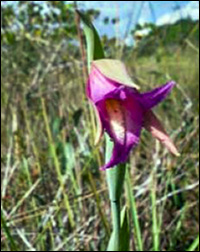 |
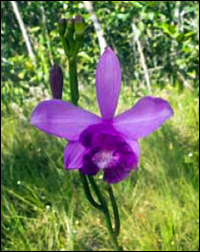 |
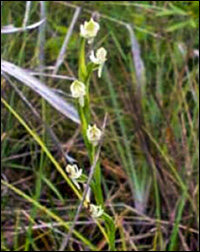 |
|
Cleistes rosea |
Epistephium parviflorum |
Habenaria schwackei |
ON: The vegetal formation is distributed between Campinarana, Campinarana transition area/Ombrophilous forest and flooded forest.
Does the campinarana have a similarity with the campinaranas around Manaus?
Same type of vegetation? The humidity issue?
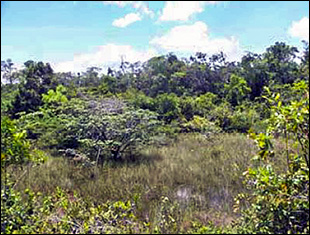 |
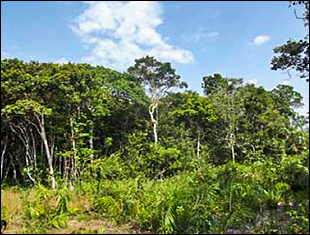 |
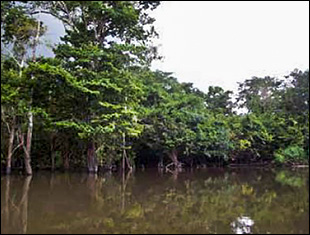 |
campinarana |
ombrophilous forest |
flooded forest |
-EP: No! It's amazing how these Amazonian open areas change the floristic composition.
The Campinaranas of Rio Negro, near Manaus, are rich in epiphytic species, they are much more diverse than those of Roraima.
The Campinaranas of PARNA Viruá are floodable and do not allow colonization by some phorophytes ideal for orchids, the tree species that occur there are not always good for orchids.
Among the epiphytes only Galeandra, Catasetum, and more rarely Aganisia. In the soil, among the Gramineae, Cyperaceae and Xyridaceae, there are Habenaria, Epistephium, Cleistes, Nohawilliamsia, Epidendrum and Duckeella.
-ON: Are the species common to all environments or is the occurrence more defined by vegetation formation?
-EP: There are 67 species of orchids in the park, few occur in all environments, and of the 13 species found in Campinaranas, 12 were restricted to this environment. Something similar with the flooded forests (with 52 species) and the terra firme (17 species) that share only 13 species.
-ON: There are so many interesting occurrences that it's hard to choose.
It is a 2013 study, but it is still not known, for example Lockhartia viruensis, which you and Marccus Alves described and published in the journal Brittonia in 2012.
What differentiates this species from Lockhartia imbricata?
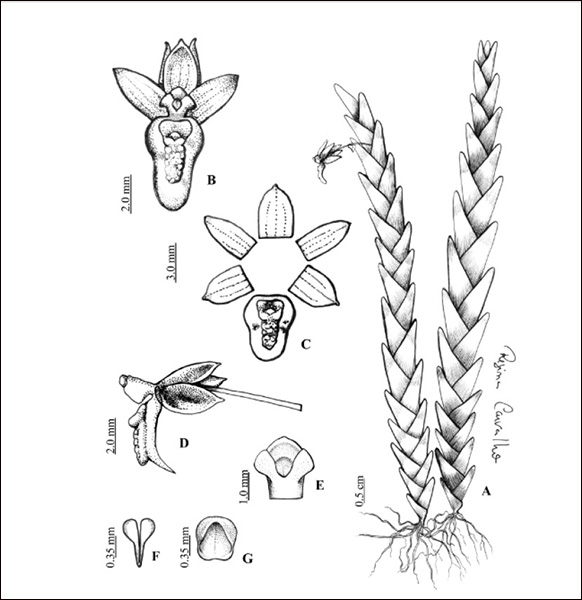
Lockhartia viruensis
-EP: The habit is identical, as well as many other species of Lockhartia, that is, without flower it is impossible to distinguish them. However, the lip is quite different, the lip in L. viruensis is entire with a round apex, the callus is papillose, and the wings of the column are entire.
-ON: Duckeella pauciflora had its first (and only?) mention for Brazil in your work. It is not a very well known orchid. What can you tell us about her?
-EP: It's a beautiful land plant, with bright yellow flowers! Duckeella is a rare genus that occurs in open areas of the Amazon and without flowers goes unnoticed, as it does not look like an orchid. Maybe that's why it has few collections. |
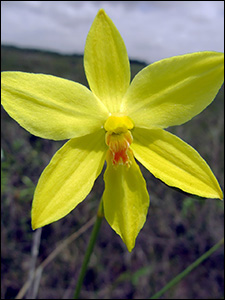 Duckeella pauciflora Duckeella pauciflora |
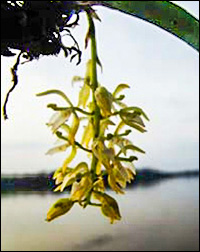 Notylia angustifolia Notylia angustifolia |
-ON: Notylia angustifolia has its quote from Roraima and a quote from Rondônia (Martuscelli, P.). Possibly, it also occurs in the state of Amazonas? Is it just a matter of not being located yet?
-EP: I am co-supervisor of a PhD student who has been studying Notylia since 2021. It is a complex genus with many more names than actual species in nature. Viruá plants were identified as N. yauaperyensis, but during the publication process some reviewer requested a change to N. angustifolia. The fact that they are synonyms still needs to be checked. These confusions with names, and publications of species already described with new local names cause these anomalous distributions, which are actually false.
-ON: Trichocentrum recurvum is another species with citation for the states of Roraima and Rondônia. Would it also be the same?
|
-EP: Someone recently sent me pictures of this species from Pará. In this second case, I agree that it is a collection problem. The Amazon is very lacking in botanists, and it is being destroyed before we can know it better.
-ON: Specklinia aristata has its citation for Roraima, it also has it for Amazonas and the state of São Paulo.
Would it really be the same species occurring in such distant regions?
-EP: This species is common in other countries, but in Brazil there are few records.
The São Paulo plant is very similar and seems to have been well identified. I have a collection of this species for the State of Ceará, collected in 2015 or 2016, but I never dedicated myself to writing anything about the finding.
These samples from the Atlantic Forest deserved a detailed study.
-ON: Anathallis amazonica is a species found and described by you, could you mention which others you found?
-EP: So far, according to the IPNI, I am the author of 33 taxa, 27 of which are in Orchidaceae.
Of these 29, two are sections in the Campylocentrum genus, which I studied for my doctorate, and five are genre transfers. The remaining 20 are new species, most of them described in collaboration.
I have already described species for all regions and ecosystems of Brazil in the genera Campylocentrum, Epidendrum, Anathallis, Chysis, Lockhartia, Masdevallia, Specklinia and Stelis.
I consider myself an expert only in the first two, which I have devoted most efforts to solving the taxonomy.
-ON: Can you observe that you found several species of Campylocentrum? What was the plant formation around? And what kind of light?
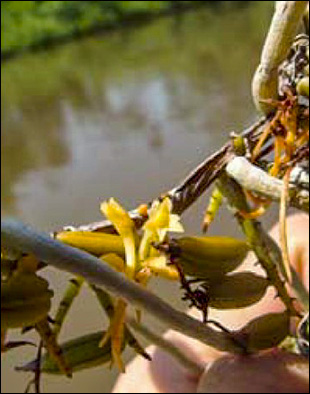 |
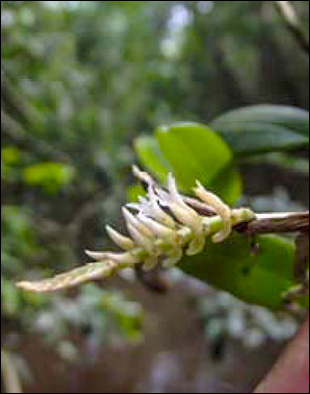 |
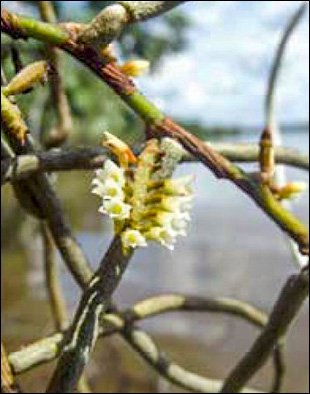 |
Campylocentrum huebneri |
Campylocentrum micranthum |
Campylocentrum poeppgii |
-EP: Campylocentrum was the genre I studied during my PhD. There were nine new species described for different ecosystems. Some from high altitude and cold areas such as Itatiaia (RJ), others collected in dry areas of the Cerrado of Minas Gerais, or even in swamps in São Paulo. There is no preference of the genus as a whole for a specific environment, it varies greatly from species to species. However, I can say that Campylocentrum cultivation is challenging. From the living collections I visited, when we went to look for the individuals, they were usually dead or dying. There were individuals in good health in the JBRJ in the nursery (greenhouse/Nursery) close to the Tropical Botany School, I don't know if they still live in the lower nursery.
-ON: Answering your question about the cultivation of Campylocentrum, the Jardim Botanico collection has some specimens. Campylocentrum brachycarpum is grown in the glass greenhouse, where it blooms well and the others are grown in the (heated) greenhouse, but have not yet flowered.
Interesting how Cleistes rosea is present in almost the entire country.
-EP: Yes, but it's not a certainty. I heard that Prof. Dr. João Batista from UFMG is studying these plants.
Who knows, we may have news soon?
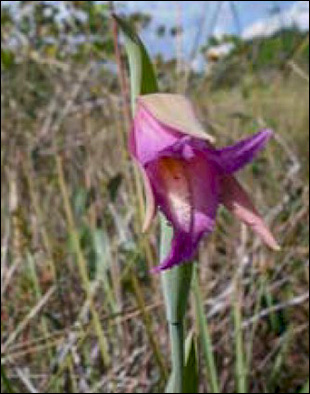 |
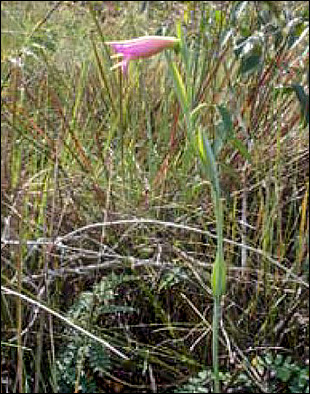 |
Cleistes rosea |
ON: In Flora do Brasil, access 05.05.22 https://floradobrasil.jbrj.gov.br/FB25927, Trichocentrum cebolleta has no record of occurrence in Brazil, however you found it in the Park...
EP: Yes, T. cebolleta (eg Cohniella, ex. Oncidium) is currently widely considered not to occur in Brazil.
Studies carried out in Costa Rica showed that this name was applied to several different species.
In the case of Brazil, these researchers pointed to the existence of three species, T. caatigaensis (in the Caatinga), T. cepula (in the Cerrado), and T. sprucei (in the Amazon).
In the flora of Brazil (2020), the first two are considered synonymous.
Finally, a master's student of mine, who has now defended in 2021, studied Brazilian populations, used an integrative approach, with molecular genetics, cytogenetics and geometric morphometry of the lips. Our results will be published soon in an international journal, I can say that the data indicate that in Brazil there is only one species, not three as advocated by Costa Ricans, nor two as stated in Flora do Brasil. However, in fact it is not T. cebolleta.
Parna Viruá's article was developed in 2012 and published in 2014.
Those were different times, with little understanding of the group.
|
![]()